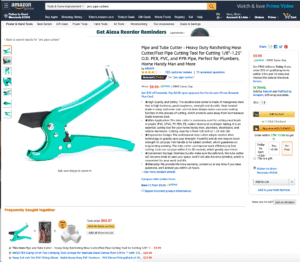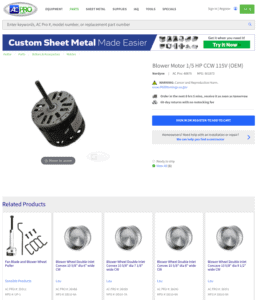
Brian Beck
In the following excerpt from his new book “Billion Dollar B2B Ecommerce,” industry expert Brian Beck tells how B2B companies can use effective ecommerce techniques to drive return on investment from digital commerce. It is one of three components of ROI covered in Chapter Three, “Customer-Centered ROI Drivers and Investment Considerations.” The book, Beck says, lays out a blueprint for how B2B companies need to address their technology and business operations to thrive in the digital age.
Increased share of a customer’s wallet is the most obvious and immediate ROI driver to successful implementation of B2B Ecommerce. By applying B2C Ecommerce best practices, B2B businesses can increase the lifetime value of existing customers by increasing each customer’s overall spend. This may seem surprising, given the fact that many B2B organizations have a dedicated sales force that is incentivized to drive more sales from their current accounts. However, a successful Ecommerce implementation can effectively expand wallet share in unexpected ways, particularly by optimizing the online shopping process for commonly re-ordered goods and making the buyer’s job easier in the process.
Increasing share of wallet through Ecommerce uses standard online cross promotion and upselling processes to introduce existing customers to products they may not know that a seller offers. Anyone who has used Amazon has seen this in the “Customers who bought this item also bought . . . ” and the “Related Products” sections on each Amazon product listing page. This kind of capability is enabled by the richness of data and actionable analytics that Ecommerce can bring to your interactions with customers. This is a function that can be difficult for a sales rep to conduct in-person, depending on the nature of the products being sold and the breadth of the catalog. Sure, sales representatives can carry around a beautiful, four-color brochure or catalogue with a company’s top products, but this is a linear way of presenting product information and not the most efficient way to introduce items that are related, sometimes in abstract ways.
Following is an example from Amazon.com, showing how the top online retailer presents related items to specific product on the page, using its “Frequently Bought Together” functionality.

On the following page is an example of how one of my clients, HVAC distributor AC Pro, uses the same concept to present related products in an elegant and easy to understand way that allows heating and air conditioning contractors to quickly find what they need to get the job done.

It is also important to note that the sales team has limited facetime with customers, and they may not have the opportunity in every meeting to present complementary products or to introduce new ones. In contrast, a well-executed Ecommerce web site can accomplish this task 100 percent of the time, especially when product information is detailed and properly categorized.
The whole idea here is to reduce friction for buyers and to make their jobs easier, while expanding the number of products purchased along the way. This is where B2B Ecommerce differs from its B2C counterpart. Oftentimes, B2C buyers are looking to browse product catalogs. They want to see options and are happy to click around a web site, casually looking at different categories and products. Online shopping for consumers is much more analogous to, say, shopping for clothes in a retail store. Indeed, online clothing retailers often see more page-views/session than other types of retailers.[1] Conversely, B2B buyers are looking for efficiency. They want to spend as little time as possible on an Ecommerce web site. They want to be able to easily find the products they need, purchase them as quickly as possible, and move on with their day. And if customers can conveniently add a few more items to their shopping cart that they either didn’t know you carried, or didn’t know they needed, then you have built loyalty, repeat business, and have ultimately grown the customer’s lifetime value.
Ecommerce also helps to build share of wallet by acting as a force multiplier to the sales team. As much as you may want to believe your sales team is acting on every lead, the fact is that they simply cannot spend time with every single customer, particularly smaller ones. To be effective, sales teams typically need to spend the majority of their energy with larger accounts that generate the highest volume. But what happens to all of the smaller customers? Should these customers’ needs go unanswered? Of course not. A B2B Ecommerce site is ideal for smaller customers. The self-service nature of the web is perfect for accommodating and supporting these customers. A well-designed Ecommerce web site will help sellers capture additional wallet share from existing small customers, and even help sellers acquire new customers they could not have adequately served without Ecommerce.
For example, one of my clients is a well-established, $300 million tool producer that owns several global tool and landscaping equipment brands. The company sells its products to large retail stores like Lowes and Home Depot, as well as to smaller, independently-owned hardware stores. While it is true that these “mom and pop” retailers are becoming fewer in number, there are still thousands of these specialty retailers in the United States. The company receives about 35 percent of its revenue from these smaller stores. Ignoring this customer base would be detrimental to their business growth – and providing an Ecommerce channel for these retailers has allowed the company to continue to capture sales that simply wouldn’t be possible with a salesperson. Ecommerce is the key to maintaining wallet share with these smaller customers.
[1] https://www.wolfgangdigital.com/blog/e-commerce-kpi-benchmarks- study-2017/
Brian Beck, an ecommerce expert, advisor and author, is managing partner of Enceiba, an agency that helps manufacturers and brands sell through Amazon.com and Amazon Business. Follow him on LinkedIn.